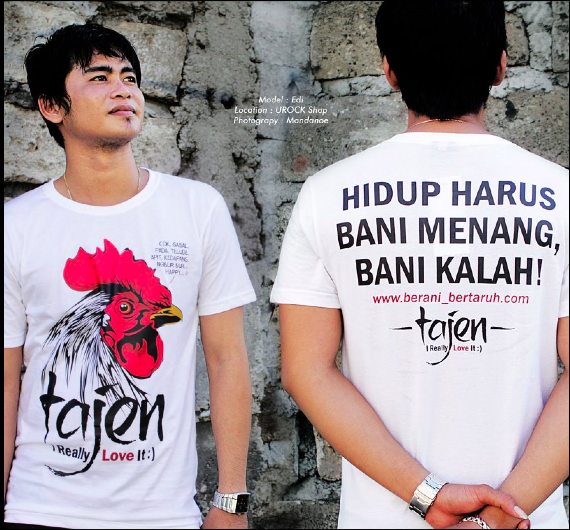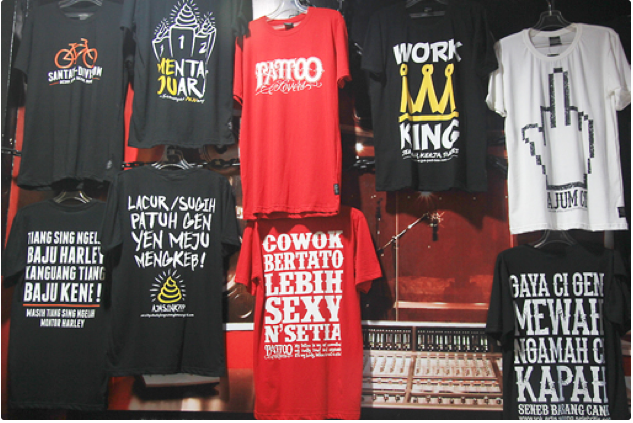Emma Baulch
Baduda. When I went to live in Bali in 2005, I kept seeing this word everywhere I went. Whenever I pulled up at a traffic light, the person in front of me would be wearing a t-shirt bearing a Baduda design. One day, the word slipped furtively into my home. Someone bought a mini-version Baduda t-shirt for my daughter, and she wore it to her day care.
Soon enough, I found out what Baduda meant and what it referred to. Baduda means ‘dung beetle’ in low Balinese, and it refers to fans of the Balinese pop performer, Nanoe Biroe. In 2005, Nanoe Biroe had only just struck out as a solo artist and released his debut album, Suba Kadung Metulis (It’s Written Now). In so doing, he joined the ranks of a new wave of Balinese pop performers that have risen up with the dawning of the new century. Members of this new wave associated singing Balinese-language pop songs with a hip, metropolitan, rock and roll-inflected culture, and drew the genre away from its overwhelmingly Mandarin pop style and rural nuances.
As he began playing around the island after the release of his debut album, Nanoe Biroe quickly became known for his easy and charismatic stage style. At shows, he intersperses his songs with a flowing banter, made light with a liberal dose of wisecracks and puns, but firmly tethered to his assessments of contemporary social ills and his suggested remedies for them. He affects a gentle, priestly style, but one packed full with a sense of fun, an unusual combination that draws his audience in and makes them feel as if they want to get close to his words. His performance style closely resembles those of Islamic preachers or motivational speakers, thereby pioneering new performance possibilities within the rubric of Balinese pop.
But Nanoe Biroe is not only a vital figure in the history of Balinese popular music. He also plays a part in the history of Balinese literature. As well as playing live shows and selling records, he is a widely published writer, but not in the conventional sense. The medium of his printed words is not paper, but fabric. Nanoe Biroe owns a successful merchandise line, and he employs t-shirts to air critiques and to proffer suggestions for resolving social problems. T-shirts are writing spaces for Nanoe Biroe.
The merchandise is the message
The t-shirts Nanoe Biroe chooses as media for his message animate his words, rendering them highly mobile and visible, and making them seem pervasive. The choice can be seen, then, as politically astute. But it can also be understood as an economic necessity. For some years, income from sales of recorded music has fallen dramatically. Due to recent regulations barring cigarette companies from sponsoring music events, live performances now have limited capacity to yield significant gains for musicians. In this context, merchandising provides a sensible solution to the challenge of falling sales of ‘physical’ recordings, and a number of musicians have merchandise businesses that serve as their primary sources of revenue.
What renders Nanoe Biroe distinct among this new group of musician-cum-merchandisers is his fondness for the printed word. While others favour logos as the central theme in their designs, Nanoe Biroe uses his to launch stinging appraisals of contemporary Balinese life. Conspicuous consumption is a particularly favoured target of Nanoe Biroe’s ire. Some designs feature the following sentiments (printed in large letters, as if they were being yelled): ‘YOU’RE SO UP YOURSELF!’, announces one. ‘WHETHER YOU’RE RICH OR POOR, YOUR SHIT STINKS JUST THE SAME!’, proclaims another. ‘YOU THINK YOU’RE SMART? I AM STUPID AND IT DOESN’T MATTER! I’D RATHER BE STUPID THAN CONCEITED!’ yet another.
A blend of solidarity, cosmopolitanism, mutual respect and honest work constitutes Nanoe Biroe’s preferred solution to the adverse consequences of economic development on the island. One of Nanoe Biroe’s most popular designs features the word ‘Menyama’ (Togetherness), the title song from Nanoe Biroe’s seventh album, Timpal Sujati (True Friend), and the word fans consistently put forward whenever I asked them what it meant to be a Nanoe Biroe fan.
Another reproduces the title of his song ‘Cewek Kafe Juga Manusia’ (Escort Girls are Human Too), calling on his fans to empathise with these women, and drawing a picture of Baduda-ness that includes them. At live performances, Nanoe Biroe often introduces the song by distinguishing the virtues of the escort girls’ hard work from the moral dangers of remaining idle and housebound. And another is inscribed with the term ‘Interbalinesia’, pointing to Nanoe Biroe’s perspective on Bali’s enmeshment in the nation.
Bali’s enmeshment in the nation
By communicating his evaluation of the problems of contemporary Bali as t-shirt-borne messages, Nanoe Biroe not only calls upon Balinese to wear his philosophy, but also invites them to act as sandwich boards for his ideas. Needless to say, many have obliged. But why? To answer this, it is worth returning to the genesis of Nanoe Biroe’s philosophy, in the word Baduda, because it sheds light on the political impulse that sparks enthusiasm for Nanoe Biroe. When Nanoe Biroe addresses his fans as Baduda, and when his fans identify as such, together they sing the virtues of the dirty, low and impure dimensions of Balinese-ness. This embracing of impurity and dirt is remarkable because it first surfaced at the height of an important shift in public talk about Balinese-ness ¬– a shift that privileged purity and high culture.
 One of Nanoe Biroe’s designs, featuring a celebration of cock-fighting. (credit: U-Rock Bali)
One of Nanoe Biroe’s designs, featuring a celebration of cock-fighting. (credit: U-Rock Bali)
Following the 2002 bombing of a night club which caused hundreds of fatalities and resulted in a downturn in the Balinese tourism industry, including widespread layoffs, the push for a return to fundamental Balinese values could be seen in the rising use of the term ajeg (stable) in public discussions about Balinese-ness. This connoted a desire to return to village agrarian values, a concern with the declining Hindu population on the island, and manifested in the increasingly visible display of symbols of ethno-religious identity. Its key mediators were various high culture elites, such as modern intellectuals with university links, and the high form of the Balinese language, which increased its role in in public discourse as it began to appear in radio, print and television news.
But the eager embrace of the word Baduda in 2005 suggested that the high culture of ajeg Bali was bypassing a rich seam of cosmopolitan populism that has played an important role in modern Balinese political history and, indeed, in the ways in which Balinese consider themselves as Indonesians. Alongside the preservationist impulse and xenophobic tendencies, well represented in public discussions of Balinese-ness immediately following the 2002 bomb, there emerged a desire to celebrate Balinese-ness in a cosmopolitan way.
Nanoe Biroe channelled this desire well. By coining Baduda, he steered people away from the notion that religious symbols and high Balinese were definitive markers of the Balinese identity, and concentrated the diffuse roughness of low Balinese into a single word. Moreover, by performing it in a style clearly inspired by Indonesian rock band Slank’s creative uses of the national lingua franca, he linked this Balinese roughness to a new, emerging sense of nationhood. At the heart of Nanoe Biroe’s popularity, then, lies an affirmation of the cosmopolitan populism that defines the nation’s default mode of multi-religious and multi-ethnic co-existence.
Textual play
Nanoe Biroe does more than dress a long-standing Balinese cosmopolitanism in contemporary clothing. The delight he derives from words reveals his interest in textual play, or in a kind of absorption in written forms of the language, that is evolving at the popular level. Such popular textual engagement had already begun to emerge prior to Nanoe Biroe’s arrival on the Bali pop scene when Balinese began responding to the pioneering, new-wave music of Lolot. Lolot was the first to set low Balinese to an alternative rock soundtrack.
With the release of his album Gumine Mangkin (The World Today) in 2003, Lolot became the first to put forward alternative possibilities for ajeg Bali, and his provocations resulted in a heightened interest in textual play among his fans. As Lolot began to perform around the island at small-scale events, and as it became clear that his performances signified something new about what it could mean to be Balinese, people scrawled his name across public surfaces in all corners of the province, evincing that mix of insouciance and angst as only graffiti can: LOLOT! This was the first sign of a popular, albeit disorganised, will among new wave pop fans to play a part in shaping ajeg Bali. Clearly, they were not satisfied with expressing this resolve merely by buying Lolot’s albums and attending his shows. They wanted to write it down where it would be seen and recognised.
LOLOT! Graffiti is not the only form of textual production to have emerged as one of the more progressive outcomes of the ajeg turn in public talk about Balinese-ness. Another well-documented example of this is a literary movement that involves ordinary people in the practice of reading and interpreting the form of sung poetry known as kidung, much of which was written in old Javanese or high Balinese. Proponents of this movement interpret their involvement as part of a broader preservationist bent but, ironically, their interest in preserving old literary traditions in and of itself wreaks social change. In contemporary Bali, mekidung (reading kidung) is overwhelmingly practised by women, and this suggests a marked increase of women’s participation in this particular kind of textual engagement. This, and other examples, such as the explosion of interest in genealogical texts, touches on the broader popularisation of textual engagement that proceeds as ajeg Bali develops.
Nanoe Biroe’s efforts to bring the literary possibilities of low Balinese into the spotlight of contemporary public life, using people’s mobile bodies as a publishing medium, can also be understood as part of this broader popularisation. It is true that ajeg Bali is often considered to denote a xenophobic impulse, but this view misses the diverse identities represented within the various celebrations of Balinese-ness that define post-authoritarian, post-bomb Bali.
So despite Nanoe Biroe’s cosmopolitan proclivities, it would be misleading to characterise his writing as resisting ajeg Bali. In many ways, he relies on key symbols that have come to be seen as defining Balinese identity in the ajeg Bali period. At U-Rock, Nanoe Biroe’s merchandise shop, his literary productions are interspersed with images of Ganesha and the omkara symbol, which adorn some of his t-shirt designs, and reveal his position within the new Hindu turn in Balinese public culture.
But at the same time, there is a refusal, on Nanoe Biroe’s part, to define Balinese-ness as only and solely Hindu. At U-rock, Lord Ganesha appears perfectly comfortable rubbing up against the words meju and mengkep (shit and fart) on the rack. He gazes down his trunk and locks eyes with James Hetfield, Metallica’s lead singer, whose image appears on a shirt hanging on the opposite wall. He glances approvingly at Munir, Iwan Fals, Soekarno and Kartini, whose silhouettes populate the wallpaper at the back of the shop. U-Rock proposes an ajeg Bali world composed of a smooth melange of committed religiosity, devotion to social justice and a love of rock and roll.
Emma Baulch (e.baulch@qut.edu.au) is a Senior Research Fellow at Queensland University of Technology.
